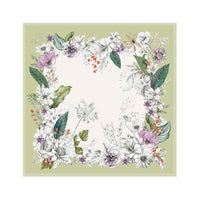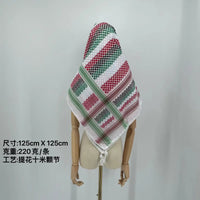The Indian scarf and shawl market is experiencing rapid expansion, with the entire textile and apparel market projected to reach $250 billion by 2026. This market has distinct religious and cultural characteristics, seasonal demand, and explosive e-commerce potential. By analyzing search results, I provide in-depth market insights and product selection recommendations from four perspectives, helping you accurately grasp the needs of Indian consumers.
一、 Market Overview and Consumption Trends
1.Market Size and Potential
- The total value of India's accessories market has exceeded 25 billion RMB, with scarves and shawls accounting for approximately 27% of the market share.
- By 2025, India's textile and apparel market is projected to reach US$220 billion, with a compound annual growth rate of 10%. This growth is driven by the expansion of the middle class (expected to reach 95 million people) and the rise of young online shoppers (online shoppers are expected to reach 450 million).
2. Consumer Characteristics
- Indian consumers have a strong preference for products with vibrant colors and intricate decorations, with religious motifs and traditional craftsmanship being key purchase drivers.
- The high-end market is experiencing significant growth (25% annually), with luxury cashmere and hand-embroidered shawls experiencing strong demand during the wedding season. Furthermore, eco-friendly materials (organic cotton, recycled blends) and multifunctional designs are emerging trends.

3. Purchase Channel Preferences
E-commerce is the primary growth engine: Platforms like Myntra and Amazon India account for over 60% of luxury scarf sales.
- Offline channels remain important, with airport retailers (such as Swarovski) accounting for a significant share of high-priced shawl sales.
二、 Analysis of Popular Styles and Product Features
1.Design Styles and Patterns
- Religious Cultural Elements: Scarves emblazoned with the words "Jai Shree Ram" (Glory to Rama) and images of the monkey god Hanuman continue to be hot sellers on Flipkart.

- Revival of Traditional Handicrafts:
- Kalamkari (Hand-block Printed) Shawls: These feature mythological figures and peacock motifs, such as a black background with gold embroidered flowers and birds, adorned with loose tassels at the ends for a luxurious touch.
- Jamawar (Heirloom Weaving) Shawls: Utilizing antique techniques, these are primarily used in the high-end wedding market.
2.2024 India hot sale promotion style recommendation
| Style | Material | Design Highlights | Suitable for Use |
| 1. Sequin Embroidery: | Rayon + Synthetic Sequins | Gold Piping + Peacock Embroidery | Suitable for weddings and holidays |
| 2.Gradient Tie-Dye Long Scarf | Micro-Viscose | Rainbow Gradient + Tasseled Edge | Suitable for everyday wear by young people |
| 3.Light Luxury Jacquard Shawl | Light Luxury Jacquard Shawl | Mughal Pattern + Silk-like Sheen | Suitable for business gifts/middle-class purchases. |
| 4. Sunscreen Chiffon Scarf | Nylon + SPF Coating | Polka Dot Print, Foldable into a Headscarf | Suitable for sun protection in southern |
| 5.Versatile Solid Color Basic | Double-Knit Cotton | Two-Color Design (e.g., Orange + Pink) | Suitable for students/low-price attraction. |

三、Promotional Strategies and Holiday Marketing Rhythms
1.Key Holidays and Promotional Periods
- October to February: Wedding season and Diwali, featuring gold embroidery and red silk shawls.
- February to April: Shivaratri and Holi, featuring colorful printed cotton scarves.
2.The following table provides key recommendations for holiday marketing:
| Festival | Time | Featured Style | Promotion Strategy |
| Diwali | October-November | October-Novembe | Free Basic Solid Color |
| Wedding Season | November-March | Heavy Sequined Pashmina Shawls | Get 200 off on orders over 3000 |
| Holi | March-April | Fluorescent Cotton and Linen Blend Scarves | Bundled with Paint Sets |

3.E-commerce Channel Operations Suggestions
Leverage limited-time offers on cross-border platforms: Use "Share to Win a Greeting Card" promotions to boost conversions.
四、Product Selection and Supply Chain Recommendations
1. Recommended Development Paths
Basic Style
60×175cm rayon/modal cotton scarves, solid color scarves/shawls.

Profitable Style:
Hand-embroidered shawl, multifunctional scarf/stole
High-End Style:
Black and gold religious totem shawl, recreating the Nehru gift style (186×55cm), targeting luxury e-commerce channels.
2. Supply Chain Optimization
- Origin Selection:
- Local Indian production: Avoids tariffs, especially for high-end products containing 30% or more silk.
- Cross-border direct mail from China: Suitable for basic rayon styles and multifunctional cotton and silk blends.
- Compliance Notes:
Religious motifs require local cultural review to avoid misuse of deities (e.g., Vishnu motifs are only used on high-end, authentic products).
Conclusion
The Indian scarf and shawl market needs to deeply integrate religious cultural attributes with modern functional design, with targeted targeting during festivals such as Holi and wedding seasons. Prioritize the development of multifunctional cotton and silk blends to enter the market, gradually expand into high-end handmade lines, and leverage the platform to achieve holiday sales. Important to note: Indian consumers are sensitive to color errors, so the "Screen Color Difference Warning" should be marked on the product details page and individual packaging should be used to prevent transportation damage.





